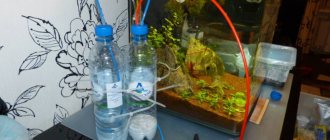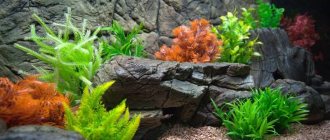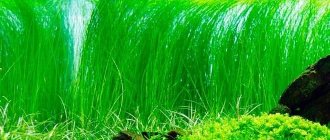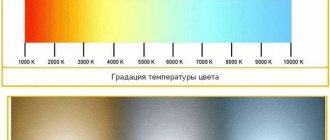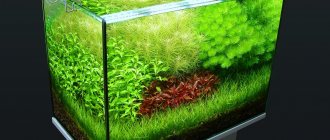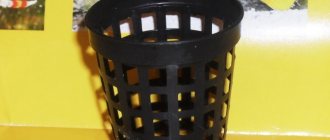Aquarium plants are aquatic species of flora that are cultivated in an aquarium (mainly freshwater). Most of these aquatic plants are of tropical origin and belong to marsh or coastal species - i.e. They are quite capable of being both submerged in water and rising above the surface of the water.
An aquarium with fish can decorate and enliven the interior of any apartment or public institution. Contemplating this small aquatic ecosystem in your own home is calming, gives you a feeling of comfort, and puts you in a positive mood. In addition to various animals (fish, snails), aquatic plants are also present in the aquarium. Depending on the type, they can be completely hidden under water or partially above it, attached to the ground or float independently in the water. Aquarium plants are mainly flowering plants, but there are also representatives of other divisions (mosses and ferns).
Breeding aquarium plants
For the growth and development of aquarium plants, as for any other photosynthetic plants, certain conditions are necessary. There are not many of them, but these requirements must be met in order for the aquarium to please the eye with lush green underwater vegetation.
First of all, you need to pay attention to the quality of the soil and substrate (a nutritious soil mixture with the necessary set of microelements) for the future aquarium. A wide range of substrates can be used and are suitable for most types of aquatic flora.
An equally important factor in plant life is sufficient lighting. To ensure this, special phytolamps are used: halogen, sodium, fluorescent, LED and incandescent lamps. The choice of lamp type depends on the plants to be grown. For example, for the less demanding cryptocoryne, echinodorus, ludwigia, hornwort, and many types of moss, moderate lighting from a fluorescent lamp is sufficient.
For full growth, carbon dioxide is also needed, which usually reaches plants in insufficient quantities from air and water. The way out of the situation would be to force the supply of CO2 using special equipment or by injecting carbon fertilizer.
Reproduction of aquarium plants - video
Decorative purpose
Consider the needs of aquatic inhabitants and the interior of the room. Think about the composition in advance. There are several rules to help create a spectacular pond:
- Place dense and large plants in the background, so they will not block other representatives of flora and fauna.
- Plant medium-sized greens in the middle or along the sides of the tank.
- Place short grass in the foreground.
- For a better view, leave a small distance from the front wall of the aquarium unoccupied.
The background
Unpretentious plants, most suitable for decorating the background:
- Indian and Thai ferns;
- lemongrass;
- hydrocotyla;
- cabomba.
Center
Place in the center:
- a small bush of ferns;
- Echinodorus;
- Vallisneria;
- blue.
Foreground
Place a small and bright flora in front:
- Marsilea hisruta;
- Anubias;
- Cryptocoryne dwarf;
- Staurogyne repens.
Plants of other colors
Dilute the greens with scarlet and purple shades:
- rotals;
- ludwigia;
- bacopa carolina;
- naiads;
- limnophiles.
To ensure rich colors, you will need fertilizer. Sufficient illumination remains the decisive factor.
Planting and maintaining aquarium plants
Plants in an aquarium are an important and complete part of the entire system. With proper provision of aquarium flora, the fish will be bright and beautiful. Residents become healthier and begin to feel more comfortable living a natural life.
Of course, living plants are not a plastic substitute and require a little more attention, but they can last much longer than plastic. Even if certain problems arise, live plants are preferable - they will serve as a full-fledged decoration if the entire aquarium system is properly organized (sufficient light and the absence of herbivorous abodes).
Both an ordinary natural pond and a home aquarium system become home not only to animals and fish, but also to a large number of plants. And it is the plants that prevent algae from multiplying and saturate the water with oxygen, while absorbing nitrogenous emissions.
There are no particular difficulties in keeping plants in an aquarium - they, just like living inhabitants, need clean water, proper soil and a sufficient level of lighting - and it is imperative to correctly select each of the indicators depending on the type of plant.
Thailand fern Microsorum pteropus
Like Anubias nana, the Thai fern in the ground, but to attach it to snags or stones: its rhizoids are also excellent at growing to the substrate. The mounting method is the same as for Anubias. However, this is where their similarities end. Unlike Anubias, the Thai fern loves bright light. It feels great in the upper part of the driftwood, almost under the very surface.
Microsorum Narrow
Microsorum dwarf
Microsorum pterygoid on stone
Microsorum pterygoid Vindelov
Microsorum pterygoid
How to grow an aquarium plant
If you don’t keep in mind rare species of aquarium plants, then you don’t foresee any particular difficulties in growing them in an aquarium. A novice aquarist will not need much: clean water and proper feeding combined with the right level of lighting. And if problems suddenly appear with the flora of the aquarium, then this can only mean one thing: some of these components were not of very high quality.
Before planting plants in the aquarium, you need to make sure that they are cleaned of all unnecessary things - algae and other dirt, and you should not forget about the dead parts of the plant, which also need to be trimmed.
Before planting, it is advisable to subject the plants to a disinfection procedure, which usually includes several options:
- placing potassium permanganate in a solution for a short time (20 minutes) - but you need to make sure that the solution is not too intense;
- providing an alum bath - it is recommended to place the plant in it for 5 minutes;
- A solution of hydrogen peroxide (one part to one part water) will give a good disinfecting effect.
And do not forget to thoroughly rinse the plant in clean water after the disinfection process.
Like all organisms, it is very important for plants in an aquarium to maintain the correct conditions for their prosperous life - you need to take into account the quality of the soil, the availability of nutrients, the degree of lighting, and the temperature of the water, its hardness and acidity. But you need to understand that algae and plants in an aquarium are not the same thing. Aquatic plants are higher flowering organisms, but algae are lower organisms (unicellular or multicellular). Algae never has flowers and can cause a lot of trouble for a new aquarium owner.
Java moss (Vesicularia sp.)
The third element of the lazy aquarium triad is Java moss (Vesicularia sp.) . Just like the first two plants, moss can be tied in bunches to driftwood and stones, and if you have a lot of moss, then wrap it around the whole snag. Don’t be alarmed that in the first couple of weeks it will look like a piece of sponge - soon this “scrub” will straighten out and turn into a beautiful fluffy bush, very elegant in appearance. If wrapping driftwood with moss seems to you an activity that is risky from the point of view of the aesthetics of your future aquarium, simply collect the moss into neat bunches, tie a small pebble to each bottom with a thread, and place it at the back and side walls, in the corners of the aquarium, and wherever you want. it will seem more interesting. Each such bunch will also quickly turn into a neat bush.
Java moss on stone
Rozhdestvensky moss
Java moss on lava
Java moss on a bioball
Diseases of aquarium plants
Like any living organism, aquatic plants are susceptible to various diseases. They can be caused by various reasons, mainly by environmental factors. If the plant has any damage, then you first need to determine whether the damage is related to the activity of fish or snails. Next, you need to check whether the plants have enough available lighting. Its deficiency is expressed in thin stems, pale color of leaves and their discarding. And too much light makes the leaves small. Dense soil leads to blackening and death of roots.
The majority of diseases are associated with a lack of nutrients. Therefore, it is important to determine exactly which elements plants lack and make up for this deficiency.
Some diseases and their causes:
- If there is a lack of carbon, the plant may stop growing;
- Leaves with light and brown spots indicate a manganese deficiency;
- Blackness and mucus at the growing points - low calcium;
- Pale leaf color occurs due to iron deficiency;
- If the leaves become netted, then the plant does not have enough potassium;
- Leaves wither from lack of nitrogen and phosphorus;
- A lack of magnesium is expressed in the yellowness of the leaves and their further death in these places.
Nymphea
Nymphea or tiger water lily. A beautiful and highly variable plant with green to red-brown leaves and variable amounts of purple spots.
Many submerged leaves grow before the floating leaves form. If you do not want to allow emergent leaves to appear, you should pinch the roots and trim off emerging leaves. The beauty and aroma of flowers can only be appreciated in open aquariums. Nutritious soil stimulates growth.
Temperature 22°- 30°C
Tolerance pH 5 - 8.
Treatment of aquarium plants
The biological balance in the aquarium system is created by plants - after all, they are able to reduce the concentration of harmful substances in the water. It is plants that represent an additional link in this chain - and this link requires care and due attention.
Moreover, each of the aquarium owners (be it a professional or a beginner) sooner or later faces the issue of keeping plants in an aquarium - with their diseases and, as a result, treatment.
Of course, each disease and each plant has its own specifics - and there can be no general recommendations here. But there is only one, universal way to solve them - a visual inspection of the entire system, and most importantly, a clear understanding of all the processes occurring in the aquarium. This will help to track the slightest problems and stop them in time.
If it is necessary to maintain biological balance and ensure a healthy system of existence of the aquarium, it is necessary to very carefully monitor not only the fish and their general well-being, but also the condition of all other inhabitants of the aquarium - including plants. Only then will each of them feel optimal.
Nomaphila straight (Nomaphila stricta) or Schisandra
Schisandra loves large containers, because it itself grows up to 30 cm, sometimes reaching the surface of the water. Moreover, in good conditions it can increase by 10 cm every week.
The leaves of the plant are light, pointed, decorative. Loves temperatures from 22 to 28°C. When grown above water, it can bloom all year round with lilac flowers that exude a honey aroma.
Propagated by cuttings , which are separated, left in the aquarium for germination, and then planted in the ground. When pruned, it forms side shoots.
Our material will tell you about methods of controlling thrips pests of indoor plants.
Read our article for professional recommendations for caring for epistomia at home.
The only condition that is necessary for this unpretentious plant to live is the presence of a sufficient layer of soil (up to 6-7 cm).
What underwater flora should you start with?
Aquarium plants of an unpretentious nature are especially often planted by beginning aquarium enthusiasts. Why do many people choose moss? Because it can be grown in hard water, it is a shade-tolerant option for a living plant landscape that is easy to feed and disinfect. Moss varieties are hardy aquarium plants that are able to please the eyes of aquarium owners and are ideal for fish.
A certain difficulty comes from aquarium plants floating in the water column. They:
- block the light for the inhabitants of the lower layers;
- often interfere with the rapid movement of fish;
- are a collection point for settled unused feed.
They should be treated against pests simultaneously with changing the water, rinsing thoroughly under running water. Why do fish love such vegetation? Because it is convenient to hide from enemies under it, watching what is happening from an ambush; There is a lot of oxygen around them, which makes it easy and pleasant to breathe.
In order for such plants to grow, the water must have:
- efficient air exchange;
- aeration;
- filtration;
- periodic disinfection.
Care is simple, but regularity and observation are important. If the moss or other planted plants turn yellow, the lemongrass falls off, and the cabomba aquatic (a plant similar to spruce) softens, Zhdanov V.S. (“Aquarium Plants”) recommends immediately understanding the problem and taking action. In this case, moss can be a specific indicator of the situation, and the way the fish behave can be a confirmation of trouble.
You can also grow aquarium greens from seeds, for example, lotus, echinodorus, nymphea. True, those who planted plants in a pot with seeds must understand that the process is complex.
